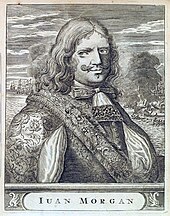Spanish rule
Christopher Columbus claimed Jamaica for Spain after landing there in 1494 and his probable landing point was Dry Harbour, now called Discovery Bay. There is some debate as to whether he landed in St. Ann's Bay or in Discovery Bay. St. Ann's Bay was named "Saint Gloria" by Columbus, as the first sighting of the land. One mile west of St. Ann's Bay is the site of the first Spanish settlement on the island, Sevilla, which was established in 1509 and abandoned around 1524 because it was deemed unhealthy. The capital was moved to Spanish Town, then called St. Jago de la Vega, around 1534 (at present-day St. Catherine).British rule
Spanish Town has the oldest cathedral of the British colonies in the Caribbean. The Spanish were forcibly evicted by the English at Ocho Rios in St. Ann. In 1655 the English, led by Sir William Penn and General Robert Venables, took over the last Spanish fort in Jamaica. The name of Montego Bay, the capital of the parish of St. James, was derived from the Spanish name manteca bahía (or Bay of Lard), alluding to the lard-making industry based on processing the numerous boars in the area.
Henry Morgan (Admiral Sir Henry Morgan
(Harri Morgan in Welsh; ca.
1635 – 25 August 1688) was an admiral of the English Royal Navy, a privateer, and a pirate[3][4][5] who made a name for
himself during activities in the Caribbean, primarily raiding Spanish
settlements. He earned a reputation as one of the most notorious and successful
privateers in history, and one of the most ruthless among those active along the
Spanish Main.) was a famous Caribbean
pirate and privateer; he had first come to the West Indies as an indentured
servant, like most of the early English colonists.
In 1394, France prohibited Jews as residents. By 1660, Jamaica had become a refuge for Jews in the New World, also attracting those who had been expelled from Spain and Portugal. A settlement of Jews had arrived in 1510, soon after the son of Christopher Columbus settled on the island. Primarily merchants and traders, the Jewish community was forced to live a clandestine life, calling themselves "Portugals". After the British took over rule of Jamaica, the Jews decided the best defense against Spain's regaining control was to encourage making the colony a base for Caribbean pirates. With the pirates installed in Port Royal, the Spanish would be deterred from attacking. The British leaders agreed with the viability of this strategy to forestall outside aggression.
When the English captured Jamaica in 1655, the Spanish colonists fled after freeing their slaves. The slaves dispersed into the mountains, joining the maroons, those who had previously escaped from the Spanish to live with the Taínos. The Jamaican Maroons fought the British during the 18th century. The name is still used today for their modern descendants. During the long centuries of slavery, Maroons established free communities in the mountainous interior of Jamaica, where they maintained their freedom and independence for generations.
During its first 200 years of British rule, Jamaica became one of the world's leading sugar-exporting, slave-dependent nations, producing more than 77,000 tons of sugar annually between 1820 and 1824. After the abolition of the slave trade in 1807, the British imported Indian and Chinese workers as indentured servants to supplement the labour pool. Many of their descendants continue to reside in Jamaica today.
By the beginning of the 19th century, Jamaica's dependence on slave labour and a plantation economy had resulted in blacks outnumbering whites by a ratio of almost 20 to 1. Although the UK had outlawed the importation of slaves, some were still smuggled into the colonies. While planning the abolition of slavery, the British Parliament passed laws to improve conditions for slaves. They banned the use of whips in the field and flogging of women; informed planters that slaves were to be allowed religious instruction, and required a free day during each week when slaves could sell their produce, prohibiting Sunday markets to enable slaves to attend church.
The House of Assembly in Jamaica resented and resisted the new laws. Members (then restricted to European-Jamaicans) claimed that the slaves were content and objected to Parliament's interference in island affairs. Slave owners feared possible revolts if conditions were lightened. Following a series of rebellions on the island and changing attitudes in Great Britain, the British government formally abolished slavery by an 1833 act, beginning in 1834, with full emancipation from chattel slavery declared in 1838. The population in 1834 was 371,070, of whom 15,000 were white, 5,000 free black; 40,000 ‘coloured’ or mixed race; and 311,070 slaves.
In the 19th century, the British established a number of botanical gardens. These included the Castleton Botanical Garden, developed in 1862 to replace the Bath Garden (created in 1779) which was subject to flooding. Bath Garden was the site for planting breadfruit, brought to Jamaica from the Pacific by Captain William Bligh. It became a staple in island diets. Other gardens were the Cinchona Plantation, founded in 1868, and the Hope Garden founded in 1874. In 1872, Kingston was designated as the island's capital.
In 1945, Sir Horace Hector Hearne became Chief Justice and Keeper of the Records in Jamaica. He headed the Supreme Court, Kingston between 1945 and 1950/1951. He moved to Kenya, which had achieved independence, where he was appointed Chief Justice.

